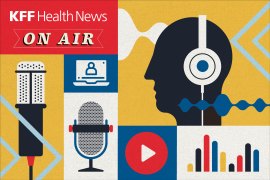CDC Rehires More Than 400 People Who Had Received Layoff Notices
Politico reports that roughly half of those rehired work for the National Center for HIV, Viral Hepatitis, STD, and Tuberculosis Prevention. Also: the effect of CDC cuts on women with chronic diseases; the oncology community sounds the alarm over budget cuts; and more.
Politico:
CDC Backtracks On Layoffs, Rehires More Than 400 People
The Centers for Disease Control and Prevention is reinstating more than 400 people who had received layoff notices, according to an email from CDC leadership to employees seen by POLITICO. The rehiring, announced internally Wednesday, marks the largest number of employees that the agency has asked back to date. (Gardner, 6/11)
Talk to us —
We’d like to speak with personnel from the Department of Health and Human Services or its component agencies about what’s happening within the federal health bureaucracy. Please message us on Signal at (415) 519-8778 or get in touch here.
More on the federal budget cuts and restructuring —
NBC News:
How CDC Cuts Affect Women With Chronic Diseases Like Sickle Cell
For D’Asia Jackson, every day is a guessing game over whether excruciating pain will upend her life. The 28-year-old medical assistant was born with sickle cell disease, an inherited condition that causes red blood cells to be shaped like a crescent moon. ... The guidelines, called the U.S. Medical Eligibility Criteria for Contraceptive Use, provided the latest research for doctors, including an app that recommended which contraceptive methods were safe. The app has been downloaded more than 440,000 times, according to the CDC. Now, the work of that team has been halted as part of the reduction of the Women’s Health and Fertility Branch of the Division of Reproductive Health. (Brooks and Essamuah, 6/11)
MedPage Today:
Oncology Community Rallies, Rails Against 'Draconian' Budget Cuts For NIH, NCI
The oncology community has sounded the alarm over the Trump administration's 2026 budget proposal, which includes near-40% cuts in funding for the NIH and National Cancer Institute (NCI). Released in early May, the proposal calls for reducing the NIH budget allocation from $46 billion to $28 billion (~39%) and NCI funding from $7.2 billion to $4.45 billion (~38%). The reductions far exceed those for the overall budget, which would trim 22.6% from all non-military spending, as compared with the current funding levels. (Bankhead, 6/11)
Stat:
NIH Autism Research Initiative Met With Skepticism From Researchers
On the surface, the National Institutes of Health’s brand new autism research initiative is alluring: $50 million to study autism’s causes and services for autistic people, and access to data from existing public and private databases. But the opportunity’s nontraditional funding mechanism, accelerated timeline, and lack of transparency around who will review the applications are casting a shadow over the initiative, which many scientists and potential applicants worry could fuel false claims about the condition. (Broderick, 6/12)
KFF Health News:
Listen: With Vital Health Research Defunded, Who’s Losing Out?
An analysis by KFF Health News found that the Trump administration’s cuts to the National Institutes of Health have been felt in both red and blue states, across political and geographic lines. Scientists warn these cuts will stall progress on urgent health issues and could set back care for vulnerable communities. More reductions in health research spending could be ahead. The Trump administration’s budget proposal for next year calls on Congress to slash the NIH budget more than 40%. (Bichell, 6/12)
Also —
The New York Times:
The Major Supreme Court Decisions in 2025
The Supreme Court is expected to release several opinions in cases the justices heard this term this morning, starting at 10 a.m. Some of them may be among the most important cases of this term, which started in October. The justices this term heard arguments on transgender rights; in three major cases on religion in public life; in two cases on efforts to curb gun violence; and in two others on limiting speech on the internet. After the election of President Trump, the court was also inundated with emergency applications arising from his scores of executive orders. Decisions in some cases have been released already; all are expected by early July. (Liptak, VanSickle and Parlapiano, 6/12)






